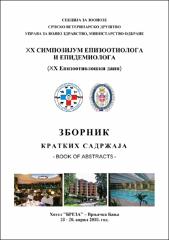| dc.contributor.author | Bugarski, Dejan | |
| dc.contributor.author | Savić, Sara | |
| dc.contributor.author | Grgić, Živoslav | |
| dc.contributor.author | Plavšić, Budimir | |
| dc.contributor.author | Uzelac, Jelica | |
| dc.contributor.author | Žekić, Marina | |
| dc.contributor.author | Petrović, Tamaš | |
| dc.contributor.author | Polaček, Vladimir | |
| dc.contributor.author | Stanojević, Slavoljub | |
| dc.date.accessioned | 2019-11-03T17:39:07Z | |
| dc.date.available | 2019-11-03T17:39:07Z | |
| dc.date.issued | 2018 | |
| dc.identifier.isbn | 978-86-83115-33-4 | |
| dc.identifier.uri | https://repo.niv.ns.ac.rs/xmlui/handle/123456789/124 | |
| dc.description.abstract | During the period of winter and early spring 2017, an epidemic of Q fever has occurred in a village named Kukujevci, in Sid municipality. After that, a broader study was performed, in order for the presence of Q fever in domestic ruminants to be identified. For the purpose of the study, Sremski County was divided into three zones. Zone 1 was village Kukujevci, zone 2 were three neighbouring villages and zone 3 was the rest of the county. The presence of Coxiella burnetii in milk bulks was confirmed by a PCR method and the presence of specific antibodies against Coxiella burnetii in milk bulks and in sheep blood samples was detected by ELISA method.
In zone 1, in total 1016 sheep and goat blood samples, from 26 flocks, were collected and analysed by serological method and in 11 herds seropositive animals were found. The seroprevalence interval between different flocks varied from 3.84% to 95.13%. From this zone, bulk milk samples were taken, 4 from cattle and 2 from goats. The presence of Coxiella burnetii was found in three cattle milk samples.
In zone 2, in total 417 sheep samples were collected, from 20 different flocks and the seroprevalence found was between 6.25% and 61.36%. Seropositive animals were found in 4 herds. Also, 4 bulk milk samples from cattle were taken and the presence of specific antibodies against Coxiella burnetii was not found.
In zone 3, a total of 74 bulk milk samples from cattle and 61 bulk milk samples from goats were collected. Specific antibodies against Coxiella burnetii were found in 9.46% of cattle milk samples and in 4.95% of goat milk samples. In zone 3 a total of 1114 sheep blood samples were collected from 36 settlements and 45 flocks. The total number of seropositive animals found in zone 3 was 108 (9.69%). Seropositive animals were found in 11 flocks (24.44%) from 9 settlements (25%), with the prevalence ranging from 1.18% to 92% on a heard level. The presence of Coxiella burnetii was found in 8 cow and 1 goat bulk milk samples. | en_US |
| dc.description.sponsorship | The research is supported by a grant from the Ministry of Education Science and Technological Development, Republic of Serbia, Projects number TR31084 and TR31071 | en_US |
| dc.language.iso | other | en_US |
| dc.publisher | Srpsko veterinarsko društvo, Sekcija za zoonoze | en_US |
| dc.source | Zbornik kratkih sadržaja, XX Simpozijum epizootiologa i epidemiologa, Vrnjačka banja, 2018 | sr |
| dc.subject | Kju groznica | en_US |
| dc.subject | domaći preživari | en_US |
| dc.subject | Srem | en_US |
| dc.title | Ispitivanje prevalence infekcije sa Coxiella burnetii kod domaćih preživara u Sremskom okrugu | en_US |
| dc.title.alternative | Study on prevalence of Coxiella burnetii infection in domestic ruminants in Sremski county | en_US |
| dc.type | Book chapter | en_US |

